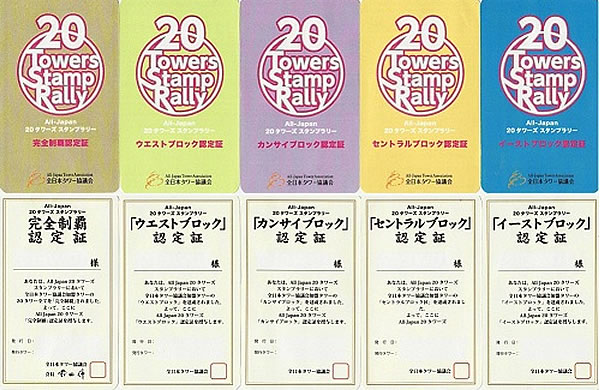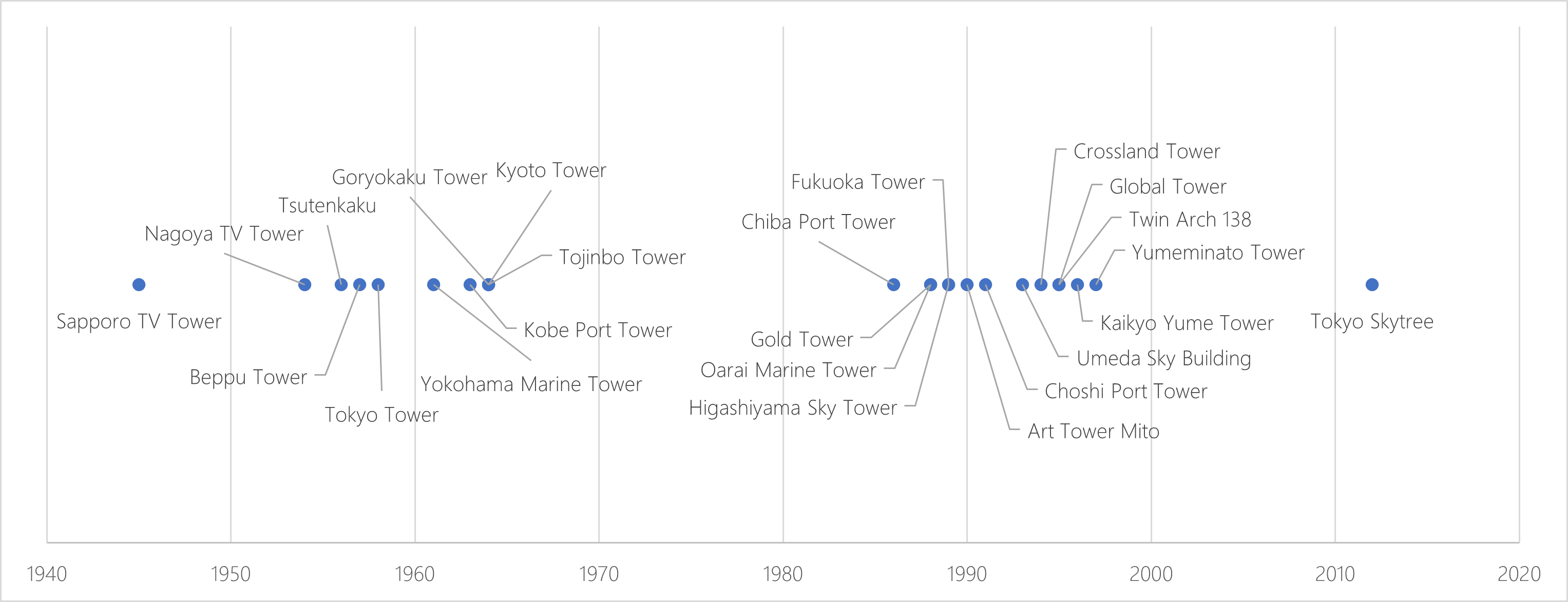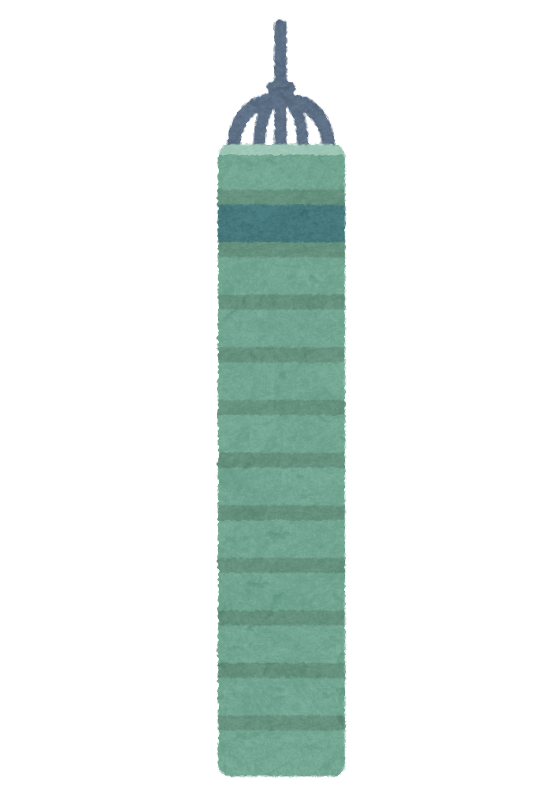Postscript I: Mystery of the Missing Tower

While looking over some of the older promotional material for the All-Japan Tower Association and the Stamp Rally, something caught my eye: they kept referring to it as the “20 Towers Stamp Rally”. Soon enough, I started noticing it everywhere, referenced on old Japanese tower otaku blogs or mentioned in the dusty, cobwebbed corners of official tower websites that someone likely forgot to update. What was the missing tower and what happened to it, I wondered. Was it in some long-forgotten corner of the country, forced to shut down when the tourists stopped coming, like so many towers not in the association? Or perhaps something more dramatic happened, like it was felled by one of the myriad natural calamities (earthquake, tsunami, eruption) that call Japan home? As a seasoned internet sleuth, it wasn’t long before I dug up the anticlimactic answer: it was both still standing and in business.
Gold Tower

Gold Tower, or “Play Park Gold Tower” as it is sometimes referred to (there seem to be some attractions for kids at the base), is located on the smallest of the four main Japanese islands, Shikoku. It’s in a small town called Utazu on the coast facing the Seto Inland Sea, right by where the Great Seto combined road/rail bridge connects Shikoku to the main island of Honshu. It’s a bit of a shame, as now there are no towers in the Stamp Rally on Shikoku, and Gold Tower is well-positioned by the bridge and railway so it would not have been too hard to fit into the itinerary as a small detour. For its modest location, Gold Tower is a surprisingly tall tower (158m), and if it was still in the Association, it would be the fifth tallest, barely edging out Kaikyo Yume Tower for the position behind the dubious “tower” that is the Umeda Sky Building. But why build such a huge tower in such a location? Sure, it has good views of the Great Seto bridge, but there’s already an elevator-type observation tower that’s far closer to the bridge, pretty much for the express purpose of viewing the bridge. Luckily, while conducted unrelated research the other day, I happened to stumble upon the answer, which in retrospect also explains the genesis of many other towers in the Association.

Above, I’ve put the opening years of every tower I’ve mentioned so far, 24 in all, on a timeline. There’s two clear clusters, or perhaps “tower booms”, one from 1954-1964, and one from 1986-1997. The first tower boom, which we can perhaps call the “Post-War Tower Boom”, coincides with Japan’s first post-occupation economic booms: the Jinmu Boom (1954-1957), the Iwato Boom(1958-1961), and the Olympics Boom (1962-1964). The towers built during this time, which start off with quite a few designed by our old friend the Tower Design King, are either practical TV towers or observation towers aimed at the increasingly prosperous population, buying TVs and travelling around. The observation towers are either in notable tourist destinations cities like Kyoto or Yokohama, or landmarks that would clearly benefit from an observation tower (Tojinbo, Goryokaku). Tsutenkaku in Osaka was built to replace a beloved landmark tower that had burned down, and once upon a time, Beppu was the Las Vegas of Japan. The key takeaway is that the locations for all the towers made sense, financial and otherwise.
Then, there’s a gap of almost twenty years with no significant towers built, with the tower-building picking up again in the mid-eighties and leading into the second tower boom. But this tower boom was fueled by something a lot more sinister... those familiar with Japanese history probably know where this is going. Yes, the second tower boom, an appropriate name for which may be the “Bubble Tower Boom”, coincides with the infamous Japanese asset price bubble of the mid-eighties to early nineties (it may seem like the towers built after 1992 or so are too late to have been products of the bubble, but keep in mind that it can take several years to plan and build a tower. Also, although the asset prices had collapsed by 1992, it still took several years before the effects were fully felt, especially the further you got from the big three cities).
Long story short, during the bubble era it was extremely easy to get huge loans, so many businesses and municipalities embarked on extremely ill-conceived construction projects, which of course ended up including quite a few towers. This is where we find a lot of towers built for the sole purpose of becoming a landmark unto themselves, with the intention to draw tourists out to small, out-of-the-way towns with not much else going on, like Mito, Yonago, Choshi, Ichinomiya, Shimonoseki, Oarai (keep in mind this was decades before the tank anime). For similar reasons, additional towers were also built in some big cities that already had older, established towers like Nagoya, Osaka, Fukuoka, and Beppu. Unfortunately, this turned out to be wishful thinking, as it turns out there’s only a few tower maniacs (like me) who are willing to travel all the way out to the boondocks just to visit a tower, in addition to the fact that tourism as a whole declined due to the post-bubble recession. In the cities where towers were added, they had difficulty competing with the older, established towers with better locations, many of which had also achieved icon status already. So, the sad truth behind many of the bubble boondoggle towers is that they’re now burdens to the communities they were supposed to invigorate, monuments to a bygone age, an age of high hopes for the future, but also an age of greed, delusion, and false prosperity.

It is in this category that we find Gold Tower, and it is in this context that I happened to stumble upon a reference to it. In an ancient blog post by an old Japan blogger who could be deemed a sort of “Bubblologist”, he mentions the Gold Tower as being in the running for the title of one of the “Three Great Structural Legacies of the Bubble”, monuments to the excesses of the Bubble that have still somehow endured to this day. An overly-huge tower in a humble town is the perfect example of the mindset that dominated the Bubble, and ultimately led to its collapse. And of course, what could signal excess more than the ostentatious gold color of the tower as a whole, from which it gets its name?
One question still remains unanswered: why is Gold Tower no longer in the All-Japan Tower Association? I dug around, and eventually found a notice on the Japanese website of the Association that said that Gold Tower was withdrawing from the Association due to “circumstances” (都合), a classic use of a Japanese business weasel word. We may never know the real reasons, but I poked around a bit longer, and it seems there’s been some extensive financial reorganization over at Gold Tower lately, including some transfers of ownership. The sort of thing that may indicate financial trouble, of the sort that happens when you take out too much debt to build an expensive tower out in the middle of nowhere that not enough people are visiting. I don’t know if the Tower Association has membership dues, but if it does, perhaps the new accountants trimming the fat decided it was no longer worth it. Will this be the start of a reversal of fortunes, or a slide into ruin for the tower, I wonder.
